Section 9. Departure Procedures and Separation
3-9-1. DEPARTURE INFORMATION
Provide current departure information, as appropriate, to departing aircraft.
a. Departure information contained in the ATIS
broadcast may be omitted if the pilot states the
appropriate ATIS code.
b. Issue departure information by including the
following:
1. Runway in use. (May be omitted if pilot states
“have the numbers.”)
2. Surface wind from direct readout dial, wind
shear detection system, or automated weather
observing system information display. (May be
omitted if pilot states “have the numbers.”)
3. Altimeter setting. (May be omitted if pilot
states “have the numbers.”)
REFERENCE-
FAAO JO 7110.65, Para
2-7-1, Current Settings.
c. Time, when requested.
d. Issue the official ceiling and visibility, when
available, to a departing aircraft before takeoff as
follows:
1. To a VFR aircraft when weather is below
VFR conditions.
2. To an IFR aircraft when weather is below
VFR conditions or highest takeoff minima,
whichever is greater.
NOTE-
Standard takeoff minimums are published in 14 CFR
Section 91.175(f). Takeoff minima other than standard are
prescribed for specific airports/runways and published in
a tabular form supplement to the FAA instrument approach
procedures charts and appropriate FAA Forms 8260.
e. Issue the route for the aircraft/vehicle to follow
on the movement area in concise and easy to
understand terms. The taxi clearance must include the
specific route to follow.
f. USAF NOT APPLICABLE. An advisory to
“check density altitude” when appropriate.
REFERENCE-
FAAO JO 7210.3, Para 2-10-6, Broadcast Density Altitude Advisory.
g. Issue braking action for the runway in use as
received from pilots or the airport management when
Braking Action Advisories are in effect.
REFERENCE-
FAAO JO 7110.65, Para
2-7-2, Altimeter Setting Issuance
Below Lowest Usable FL.
FAAO JO 7110.65, Para
3-1-8, Low Level Wind
Shear/Microburst Advisories.
FAAO JO 7110.65, Para
3-3-5, Braking Action Advisories.
P/CG Term- Braking Action Advisories.
h. When the ATIS is
unavailable, and when the runway length available for departure has been
temporarily shortened, controllers must ensure that pilots receive the runway
number combined with a shortened announcement for all departing aircraft.
PHRASEOLOGY-
RUNWAY (NUMBER) SHORTENED
EXAMPLE –
“Runway Two-Seven shortened.”
3-9-2. DEPARTURE DELAY INFORMATION
USA/USAF/USN NOT APPLICABLE
When gate-hold procedures are in effect, issue the
following departure delay information as appropriate:
REFERENCE-
FAAO JO 7210.3, Para 10-4-3, Gate Hold Procedures.
a. Advise departing aircraft the time at which the
pilot can expect to receive engine startup advisory.
PHRASEOLOGY-
GATE HOLD PROCEDURES ARE IN EFFECT. ALL
AIRCRAFT CONTACT (position) ON (frequency) FOR
ENGINE START TIME. EXPECT ENGINE START/TAXI
(time).
b. Advise departing aircraft when to start engines
and/or to advise when ready to taxi.
PHRASEOLOGY-
START ENGINES, ADVISE WHEN READY TO TAXI,
or
ADVISE WHEN READY TO TAXI.
c. If the pilot requests to hold in a delay absorbing
area, the request must be approved if space and traffic
conditions permit.
d. Advise all aircraft on GC/FD frequency upon
termination of gate hold procedures.
PHRASEOLOGY-
GATE HOLD PROCEDURES NO LONGER IN EFFECT.
3-9-3. DEPARTURE CONTROL
INSTRUCTIONS
Inform departing IFR, SVFR, VFR aircraft receiving
radar service, and TRSA VFR aircraft of the
following:
a. Before takeoff.
1. Issue the appropriate departure control
frequency and beacon code. The departure control
frequency may be omitted if a SID has been or will be
assigned and the departure control frequency is
published on the SID.
PHRASEOLOGY-
DEPARTURE FREQUENCY (frequency), SQUAWK
(code).
2. Inform all departing IFR military turboprop/turbojet aircraft (except transport and cargo types) to
change to departure control frequency. If the local
controller has departure frequency override, transmit
urgent instructions on this frequency. If the override
capability does not exist, transmit urgent instructions
on the emergency frequency.
PHRASEOLOGY-
CHANGE TO DEPARTURE.
3. USAF. USAF control towers are authorized
to inform all departing IFR military transport/cargo
type aircraft operating in formation flight to change
to departure control frequency before takeoff.
b. After takeoff.
1. When the aircraft is about 1/2 mile beyond the
runway end, instruct civil aircraft, and military
transport, and cargo types to contact departure
control, provided further communication with you is
not required.
2. Do not request departing military turboprop/turbojet aircraft (except transport and cargo types) to
make radio frequency or radar beacon changes before
the aircraft reaches 2,500 feet above the surface.
REFERENCE-
FAAO JO 7110.65, Para
7-2-1, Visual Separation.
3-9-4. LINE UP AND WAIT (LUAW)
a. The intent of LUAW is to position aircraft for an
imminent departure. Authorize an aircraft to line up
and wait, except as restricted in subpara g, when
takeoff clearances cannot be issued because of traffic.
Issue traffic information to any aircraft so authorized.
Traffic information may be omitted when the traffic
is another aircraft which has landed on or is taking off
the runway and is clearly visible to the holding
aircraft. Do not use conditional phrases such as
“behind landing traffic” or “after the departing
aircraft.”
b. First state the runway
number followed by the line up and wait clearance.
PHRASEOLOGY-
RUNWAY (number), LINE UP AND WAIT.
c. Procedures.
1. At facilities without a safety logic system or
facilities with the safety logic system in the limited
configuration:
(a) Do not issue a landing clearance to an
aircraft requesting a full-stop, touch-and-go,
stop-and-go, option, or unrestricted low approach on
the same runway with an aircraft that is holding in
position or taxiing to line up and wait until the aircraft
in position starts takeoff roll.
(b) Do not authorize an aircraft to LUAW if
an aircraft has been cleared to land, touch-and-go,
stop-and–go, option, or unrestricted low approach on
the same runway.
PHRASEOLOGY-
RUNWAY (number), CONTINUE, TRAFFIC HOLDING
IN POSITION.
EXAMPLE-
“American 528, Runway Two-Three continue, traffic
holding in position.”
2. Except when reported weather conditions are
less than ceiling 800 feet or visibility less than 2
miles, facilities using the safety logic system in the
full core alert mode:
(a) May issue a landing clearance for a
full-stop, touch-and-go, stop-and-go, option, or
unrestricted low approach to an arriving aircraft with
an aircraft holding in position or taxiing to LUAW on
the same runway, or
(b) May authorize an aircraft to LUAW when
an aircraft has been cleared for a full stop,
touch-and-go, stop-and-go, option, or unrestricted
low approach on the same runway.
REFERENCE-
FAAO JO 7110.65, Para
3-10-5, Landing Clearance.
d. When an aircraft is authorized to line up and
wait, inform it of the closest traffic requesting a
full-stop, touch-and-go, stop-and- go, option, or
unrestricted low approach to the same runway.
EXAMPLE-
“United Five, Runway One Eight, line up and wait. Traffic
a Boeing Seven Thirty Seven, six mile final.
e. USAF/USN. When an aircraft is authorized to
line up and wait, inform it of the closest traffic within
6 miles on final approach to the same runway. If the
approaching aircraft is on a different frequency,
inform it of the aircraft taxiing into position.
f. Do not authorize an aircraft to line up and wait
when the departure point is not visible from the tower,
unless the aircraft's position can be verified by ASDE
or the runway is used for departures only.
g. An aircraft may be authorized to line up and
wait at an intersection between sunset and sunrise
under the following conditions:
1. The procedure must be approved by the
appropriate Director, Terminal Operations (service
area) as well as the Director, Terminal Safety and
Operations Support.
2. The procedure must be contained in a facility
directive.
3. The runway must be used as a departure-only
runway.
4. Only one aircraft at a time is permitted to line
up and wait on the same runway.
5. Document on FAA Form 7230-4, Daily
Record of Facility Operation, the following: “LUAW
at INT of RWY (number) and TWY (name) IN
EFFECT” when using runway as a departure-only
runway. “LUAW at INT of RWY (number) and TWY
(name) SUSPENDED������ when runway is not used as
a departure-only runway.
h. Do not authorize an aircraft to line up and wait
at anytime when the intersection is not visible from
the tower.
i. Do not authorize aircraft to simultaneously line
up and wait on the same runway, between sunrise and
sunset, unless the local assist/local monitor position
is staffed.
j. USN. Do not authorize aircraft to line up and
wait simultaneously on intersecting runways.
PHRASEOLOGY-
CONTINUE HOLDING,
or
TAXI OFF THE RUNWAY.
REFERENCE-
FAAO JO 7110.65, Para
3-10-10, Altitude Restricted Low
Approach.
k. When aircraft are authorized to line up and wait
on runways that intersect, traffic must be exchanged
between that aircraft and the aircraft that is authorized
to line up and wait, depart, or arrive to the intersecting
runway(s).
EXAMPLE-
“United Five, Runway Four, line up and wait, traffic
holding Runway Three-One.”
“Delta One, Runway Three-One, line up and wait, traffic
holding Runway Four.”
Or, when issuing traffic information to an arrival aircraft
and an aircraft that is holding on runway(s) that
intersect(s):
“Delta One, Runway Four, line up and wait, traffic landing
Runway Three-One.”
“United Five, Runway Three-One, cleared to land. Traffic
holding in position Runway Four.”
Or, when issuing traffic information to a departing aircraft
and an aircraft that is holding on runway(s) that
intersect(s):
“Delta One, Runway Three-One, line up and wait, traffic
departing Runway Four.”
“United Five, Runway Four, cleared for takeoff, traffic
holding in position Runway Three-One.”
REFERENCE-
FAAO JO 7110.65, Para 3-9-8, Intersecting Runway Separation.
FAAO JO 7110.65, Para
3-10-4, Intersecting Runway
Separation.
l. When a local controller delivers or amends an
ATC clearance to an aircraft awaiting departure and
that aircraft is holding short of a runway or is holding
in position on a runway, an additional clearance must
be issued to prevent the possibility of the aircraft
inadvertently taxiing onto the runway and/or
beginning takeoff roll. In such cases, append one of
the following ATC instructions as appropriate:
1. HOLD SHORT OF RUNWAY, or
2. HOLD IN POSITION.
m. USAF/USN. When issuing additional instructions or information to an aircraft holding in takeoff
position, include instructions to continue holding or
taxi off the runway, unless it is cleared for takeoff.
PHRASEOLOGY-
CONTINUE HOLDING,
or
TAXI OFF THE RUNWAY.
REFERENCE-
FAAO JO 7110.65, Para
3-10-10, Altitude Restricted Low
Approach.
n. When authorizing an aircraft to line up and wait
at an intersection, state the runway intersection.
PHRASEOLOGY-
RUNWAY (number) AT (taxiway designator), LINE UP
AND WAIT.
o. When two or more aircraft call the tower ready
for departure, one or more at the full length of a
runway and one or more at an intersection, state the
location of the aircraft at the full length of the runway
when authorizing that aircraft to line up and wait.
PHRASEOLOGY-
RUNWAY (number), FULL-LENGTH, LINE UP AND
WAIT.
EXAMPLE-
“American Four Eighty Two, Runway Three-Zero full
length, line up and wait.”
NOTE-
The controller need not state the location of the aircraft
departing the full length of the runway if there are no
aircraft holding for departure at an intersection for that
same runway.
p. Do not use the
term “full length” when the runway length available for departure has been
temporarily shortened. On permanently shortened runways, do not use the term
“full length” until the A/FD is updated to include the change(s).
NOTE-
The use of the term “full length” could be interpreted by the pilot(s) as the
available runway length prior to the runway being shortened.
q. Whenever a runway
length has been temporarily or permanently shortened, state the word “shortened”
immediately following the runway number as part of the line up and wait
clearance.
1. The addition of
“shortened” must be included in the line up and wait clearance for the duration
of the construction project when the runway is temporarily shortened.
2. The addition of
“shortened” must be included in the line up and wait clearance until the A/FD is
updated to include the change(s) when the runway is permanently shortened.
PHRASEOLOGY-
RUNWAY (number) SHORTENED, LINE UP AND WAIT.
EXAMPLE-
“Runway Two-Seven shortened, line up and wait.”
REFERENCE-
FAAO JO 7210.3, Para 10-3-11, Airport Construction
FAAO JO 7210.3, Para 10-3-12, Change in Runway Length Due to Construction
3-9-5. ANTICIPATING SEPARATION
Takeoff clearance needs not be withheld until
prescribed separation exists if there is a reasonable
assurance it will exist when the aircraft starts takeoff
roll.
REFERENCE-
P/CG Term- Clear of the Runway.
3-9-6. SAME RUNWAY SEPARATION
Separate a departing aircraft from a preceding
departing or arriving aircraft using the same runway
by ensuring that it does not begin takeoff roll until:
a. The other aircraft has departed and crossed the
runway end or turned to avert any conflict. (See
FIG 3-9-1.) If you can determine distances by
reference to suitable landmarks, the other aircraft
needs only be airborne if the following minimum
distance exists between aircraft: (See FIG 3-9-2.)
1. When only Category I aircraft are involved-
3,000 feet.
2. When a Category I aircraft is preceded by a
Category II aircraft- 3,000 feet.
3. When either the succeeding or both are
Category II aircraft- 4,500 feet.
4. When either is a Category III aircraft-
6,000 feet.
5. When the succeeding aircraft is a helicopter,
visual separation may be applied in lieu of using
distance minima.
FIG 3-9-1
Same Runway Separation
[View 1]
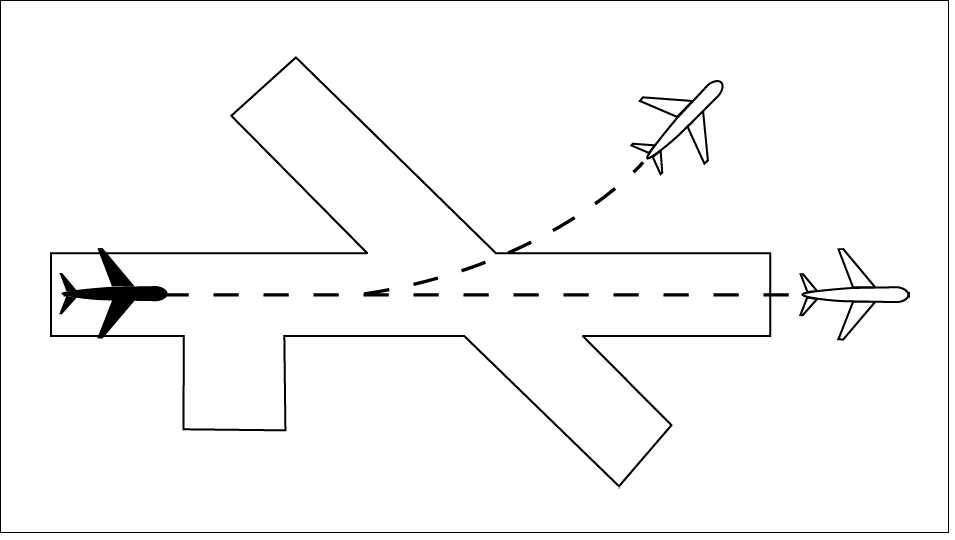
FIG 3-9-2
Same Runway Separation
[View 2]
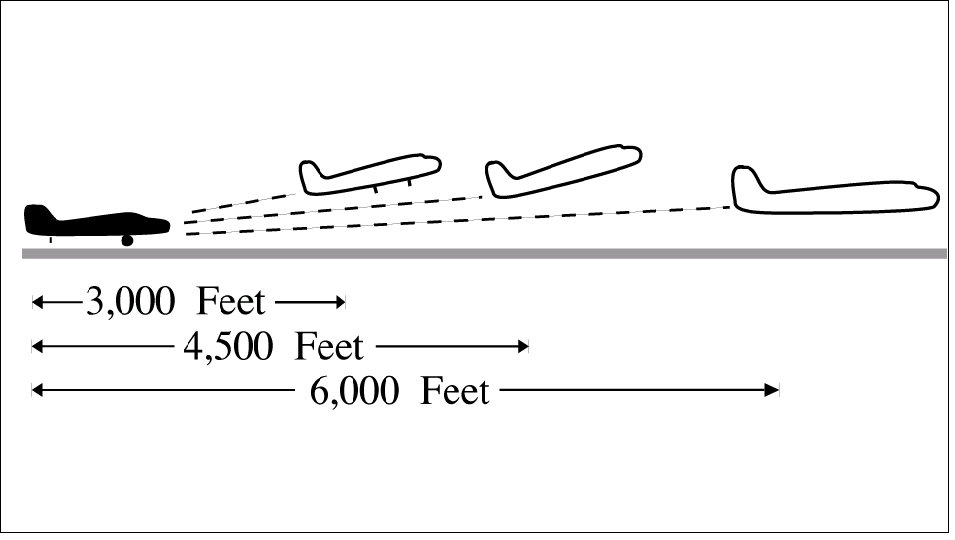
NOTE-
Aircraft same runway separation (SRS) categories are
specified in Appendices A, B, and C and based upon the
following definitions:
CATEGORY I- small aircraft weighing 12,500 lbs. or less,
with a single propeller driven engine, and all helicopters.
CATEGORY II- small aircraft weighing 12,500 lbs. or
less, with propeller driven twin-engines.
CATEGORY III- all other aircraft.
b. A preceding landing aircraft is clear of the
runway. (See FIG 3-9-3.)
FIG 3-9-3
Preceding Landing Aircraft Clear of Runway
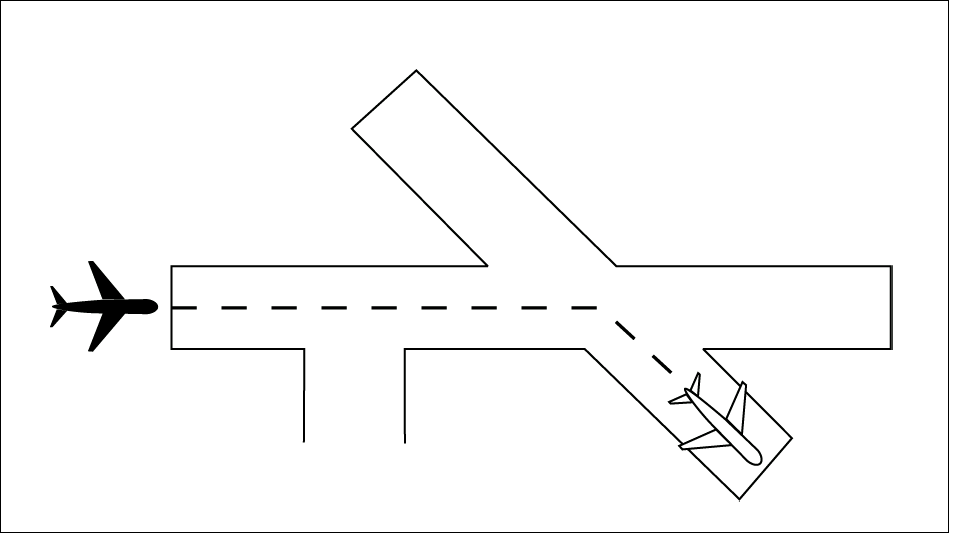
REFERENCE-
P/CG Term- Clear of the Runway.
|
WAKE TURBULENCE APPLICATION
|
c. Do not issue clearances which imply or indicate
approval of rolling takeoffs by heavy jet aircraft
except as provided in para
3-1-14, Ground
Operations When Volcanic Ash is Present.
d. Do not issue clearances to a small aircraft to line
up and wait on the same runway behind a departing
heavy jet aircraft to apply the necessary intervals.
REFERENCE-
AC 90-23, Aircraft Wake Turbulence.
e. The minima in para
5-5-4, Minima,
may be applied in lieu of the 2 minute requirement in
subpara f. When para
5-5-4, Minima, are
applied, ensure that the appropriate radar separation
exists at or prior to the time an aircraft becomes
airborne when taking off behind a heavy jet/B757.
NOTE-
The pilot may request additional separation; i.e., 2 minutes
vs. 4 miles, but should make this request before taxiing on
the runway.
f. Separate IFR/VFR aircraft taking off behind a
heavy jet/B757 departure by 2 minutes, when
departing:
NOTE-
Takeoff clearance to the following aircraft should not be
issued until 2 minutes after the heavy jet/B757 begins
takeoff roll.
1. The same runway. (See FIG 3-9-4.)
FIG 3-9-4
2 Minute Separation
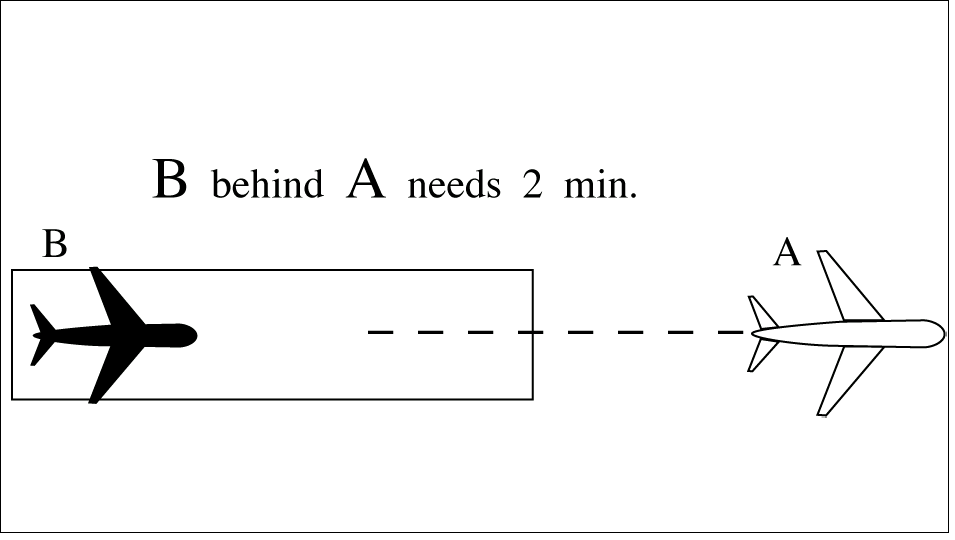
2. A parallel runway separated by less than
2,500 feet.
g. Separate an aircraft from a heavy jet/B757 when
operating on a runway with a displaced landing
threshold if projected flight paths will cross-
2 minutes when:
1. A departure follows a heavy jet/B757 arrival.
2. An arrival follows a heavy jet/B757 departure.
h. Air traffic controllers must not approve pilot
requests to deviate from the required wake turbulence
time interval if the preceding aircraft is a heavy
jet/B757.
i. Separate a small aircraft behind a large aircraft
that has departed or made a low/missed approach
when utilizing opposite direction takeoffs on the
same runway by 3 minutes unless a pilot has initiated
a request to deviate from the 3-minute interval. In the
latter case, issue a wake turbulence advisory before
clearing the aircraft for takeoff. Controllers must not
initiate or suggest a waiver of the 3-minute rule.
NOTE-
A request for takeoff does not initiate a waiver request.
REFERENCE-
FAAO JO 7110.65,
Appendix A,
Appendix B, and
Appendix C, Aircraft Information.
j. Separate aircraft behind a heavy jet/B757 that
has departed or made a low/missed approach when
utilizing opposite direction takeoffs or landings on
the same or parallel runways separated by less than
2,500 feet- 3 minutes.
k. Inform an aircraft when it is necessary to hold
in order to provide the required 3-minute interval.
PHRASEOLOGY-
HOLD FOR WAKE TURBULENCE.
REFERENCE-
FAAO JO 7110.65, Para 3-9-7, Wake Turbulence Separation for
Intersection Departures.
3-9-7. WAKE TURBULENCE SEPARATION
FOR INTERSECTION DEPARTURES
a. Apply the following wake turbulence criteria
for intersection departures:
1. Separate a small aircraft taking off from an
intersection on the same runway (same or opposite
direction takeoff) behind a preceding departing large
aircraft by ensuring that the small aircraft does not
start takeoff roll until at least 3 minutes after the large
aircraft has taken off.
2. Separate any aircraft taking off from an
intersection on the same runway (same or opposite
direction takeoff), parallel runways separated by less
than 2,500 feet, and parallel runways separated by
less than 2,500 feet with runway thresholds offset by
500 feet or more, by ensuring that the aircraft does not
start takeoff roll until at least 3 minutes after a heavy
aircraft/B757 has taken off.
NOTE-
Parallel runways separated by less than 2,500 feet with
runway thresholds offset by less than 500 feet must apply
para 3-9-6, Same Runway Separation, subpara f.
3. Separate a small aircraft weighing 12,500 lbs.
or less taking off from an intersection on the same
runway (same or opposite direction takeoff) behind a
preceding small aircraft weighing more than
12,500 lbs. by ensuring the following small aircraft
does not start takeoff roll until at least 3 minutes after
the preceding aircraft has taken off.
4. Inform an aircraft when it is necessary to hold
in order to provide the required 3-minute interval.
PHRASEOLOGY-
HOLD FOR WAKE TURBULENCE.
NOTE-
Aircraft conducting touch-and-go and stop-and-go
operations are considered to be departing from an
intersection.
REFERENCE-
FAAO JO 7110.65, Para 3-8-2, Touch-and-Go or
Stop-and-Go or Low Approach.
b. The 3-minute interval is not required when:
1. A pilot has initiated a request to deviate from
that interval unless the preceding departing aircraft is
a heavy aircraft/B757.
NOTE-
A request for takeoff does not initiate a waiver request; the
request for takeoff must be accomplished by a request to
deviate from the 3-minute interval.
2. USA NOT APPLICABLE. The intersection
is 500 feet or less from the departure point of the
preceding aircraft and both aircraft are taking off in
the same direction.
3. Successive touch-and-go and stop-and-go
operations are conducted with a small aircraft
following another small aircraft weighing more than
12,500 lbs. or a large aircraft in the pattern, or a small
aircraft weighing more than 12,500 lbs. or a large
aircraft departing the same runway, provided the pilot
of the small aircraft is maintaining visual separation/spacing behind the preceding large aircraft. Issue a
wake turbulence cautionary advisory and the position
of the large aircraft.
EXAMPLE-
“Caution wake turbulence, DC-9 on base leg.”
4. Successive touch-and-go and stop-and-go
operations are conducted with any aircraft following
a heavy aircraft/B757 in the pattern, or heavy
aircraft/B757 departing the same runway, provided
the pilot of the aircraft is maintaining visual
separation/spacing behind the preceding heavy
aircraft/B757. Issue a wake turbulence cautionary
advisory and the position of the heavy aircraft/B757.
EXAMPLE-
“Caution wake turbulence, heavy Lockheed C5A departing runway two three.”
5. If action is initiated to reduce the separation
between successive touch-and-go or stop-and-go
operations, apply 3 minutes separation.
c. When applying the provision of subpara b:
1. Issue a wake turbulence advisory before
clearing the aircraft for takeoff.
2. Do not clear the intersection departure for an
immediate takeoff.
3. Issue a clearance to permit the trailing aircraft
to deviate from course enough to avoid the flight path
of the preceding large departure when applying
subpara b1 or b2.
4. Separation requirements in accordance with
para 3-9-6, Same Runway Separation, must also
apply.
REFERENCE-
FAAO JO 7110.65, Para 3-9-6, Same Runway Separation.
3-9-8. INTERSECTING
RUNWAY OPERATIONS
a. Issue traffic information to each aircraft
operating on intersecting runways.
b. Separate departing aircraft from another
aircraft using an intersecting runway by ensuring that
the departure does not begin takeoff roll until one of
the following exists:
REFERENCE-
FAAO JO 7110.65, Para 2-1-21, Traffic Advisories.
1. The preceding aircraft has departed and
passed the intersection or is turning to avert any
conflict. (See FIG 395).
FIG 3-9-5
Intersecting Runway Separation
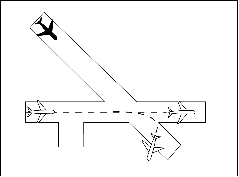
2. A preceding arriving aircraft is clear of the
landing runway, completed the landing roll and will
hold short of the intersection, or has passed the
intersection. (See FIG 396).
REFERENCE-
P/CG Term- Clear of the Runway.
FIG 3-9-6
Intersecting Runway Separation
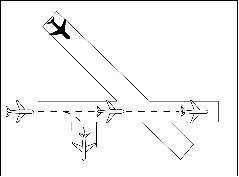
|
WAKE TURBULENCE APPLICATION
|
3. Separate IFR/VFR aircraft taking off behind
a heavy jet/B757 departure by 2 minutes when
departing:
NOTE-
Takeoff clearance to the following aircraft should not be
issued until 2 minutes after the heavy jet/B757 begins
takeoff roll.
(a) Intersecting runways if projected flight
paths will cross. (See FIG 3-9-7).
FIG 3-9-7
Intersecting Runways
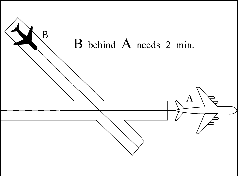
(b) A parallel runway separated by 2,500 feet
or more if projected flight paths will cross.
(See FIG 3-9-8.)
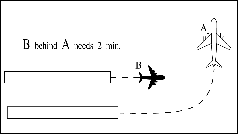
4. Separate IFR/VFR aircraft departing behind
a landing heavy jet/B757 on an intersecting g runway
if the departure will fly through the airborne path of
the arrival- 2 minutes. (See FIG 3-9-9.)
FIG 3-9-9
Departure on Intersecting Runway
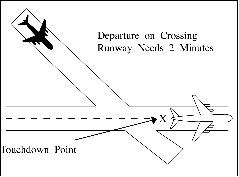
5. Air traffic controllers must not approve pilot
requests to deviate from the required wake turbulence
time interval if the preceding aircraft is a heavy
jet/B757.
REFERENCE-
FAAO JO 7110.65, Para #, Successive or Simultaneous
Departures.
FAAO JO 7110.65, Para #, Departures and Arrivals on
Parallel or Nonintersecting Diverging Runways.
3-9-9. NONINTERSECTING CONVERGING
RUNWAY OPERATIONS
a. Separate departing aircraft from an aircraft
using a nonintersecting runway when the flight paths
intersect by ensuring that the departure does not begin
takeoff roll until one of the following exists:
REFERENCE-
FAAO JO 7110.65, Para 2-1-21, Traffic Advisories.
1. The preceding aircraft has departed and
crossed the departure runway, or is turning to avert
any conflict. (See FIG 3-9-10).
FIG 3-9-10
Intersecting Runway Separation
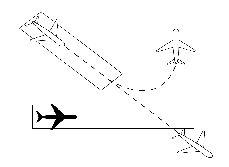
2. A preceding arriving aircraft has completed
the landing roll and will hold short of the projected
intersection, passed the projected intersection, or has
crossed over the departure runway (See FIG 3-9-11
and FIG 3912).
FIG 3-9-11
Intersecting Runway Separation
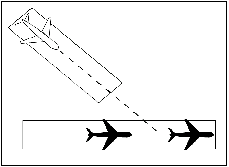
FIG 3-9-12
Intersecting Runway Separation
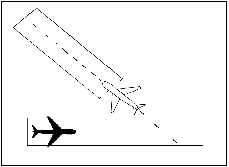
|
WAKE TURBULENCE APPLICATION
|
b. Separate IFR/VFR aircraft taking off behind a
heavy jet/B757 departure by 2 minutes when
departing a crossing runway if projected flight paths
will cross. (See FIG 3-9-13).
FIG 3-9-13
Intersecting Runway Separation
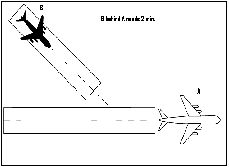
NOTE-
Takeoff clearance to the following aircraft should not be
issued until 2 minutes after the heavy jet/B757 begins
takeoff roll.
c. Separate IFR/VFR aircraft departing behind a
landing heavy jet/B757 on a crossing runway if the
departure will fly through the airborne path of the
arrival 2 minutes. (See FIG 3-9-14).
FIG 3-9-14
Intersecting Runway Separation
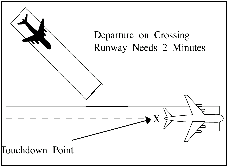
d. Air traffic controllers must not approve pilot
requests to deviate from the required wake turbulence
time interval if the preceding aircraft is a heavy
jet/B757.
REFERENCE-
FAAO JO 7110.65, Para 583, Successive or Simultaneous
Departures.
FAAO JO 7110.65, Para 585, Departures and Arrivals on Parallel or
Nonintersecting Diverging Runways.
e. If the extended centerline of a runway crosses a
converging runway or the extended centerline of a
converging runway within 1 NM of either departure
end, apply the provisions of Paragraph 398,
Intersecting Runway Separation. (See FIG 3915).
REFERENCE-
FAAO JO 7210.3, Para 10314, GoAround/Missed Approach
FIG 3-9-15
Intersecting Runway Separation
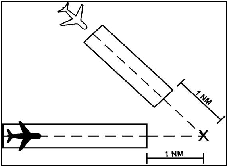
FIG 3-9-16
Intersecting Runway Separation
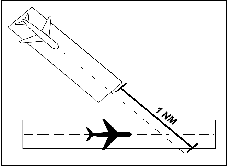
3-9-10. TAKEOFF CLEARANCE
a. When issuing a clearance for takeoff, first state
the runway number followed by the takeoff
clearance.
PHRASEOLOGY-
RUNWAY (number), CLEARED FOR TAKEOFF.
EXAMPLE-
“RUNWAY TWO SEVEN, CLEARED FOR TAKEOFF.”
NOTE-
Turbine-powered aircraft may be considered ready for
takeoff when they reach the runway unless they advise
otherwise.
REFERENCE-
FAAO JO 7110.65, Para 4-3-1, Departure Terminology.
b. When clearing an aircraft for takeoff from an
intersection, state the runway intersection.
PHRASEOLOGY-
RUNWAY (number) AT (taxiway designator) CLEARED
FOR TAKEOFF.
c. When two or more aircraft call the tower ready
for departure, one or more at the full length of a
runway and one or more at an intersection, state the
location of the aircraft at the full length of the runway
when clearing that aircraft for takeoff.
PHRASEOLOGY-
RUNWAY (number), FULL LENGTH, CLEARED FOR
TAKEOFF.
EXAMPLE-
“American Four Eighty Two, Runway Three Zero full
length, cleared for takeoff.”
d. The controller must ensure that all runways
along the taxi route that lead to the departure runway
are crossed before the takeoff clearance is issued,
except as stated in para 3-9-9e.
FIG 3-9-17
Runway/Taxiway Proximity
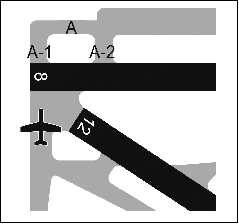
e. At those airports where the airport configuration
does not allow for an aircraft to completely cross one
runway and hold short of the departure runway and/or
where airports do not have runway hold markings
between runways, state the runway to be crossed with
the takeoff clearance if the aircraft is not able to
complete a runway crossing before reaching its
departure runway.
PHRASEOLOGY-
CROSS RUNWAY (number), RUNWAY (number)
CLEARED FOR TAKEOFF.
EXAMPLE-
“CROSS RUNWAY TWO FOUR LEFT, RUNWAY TWO
FOUR RIGHT, CLEARED FOR TAKEOFF.”
FIG 3-9-18
Runway/Taxiway Proximity
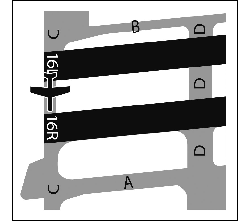
REFERENCE-
FAAO JO 7210.3, Para 10-3-9, Takeoff Clearance.
P/CG Term- Clear of the Runway.
f. Do not use the term “full length” when the
runway length available for departure has been
temporarily shortened. On permanently shortened
runways, do not use the term “full length” until the
Airport/Facility Directory is updated to include the
change(s).
NOTE-
The use of the term “full length” could be interpreted by the
pilot(s) as the available runway length prior to the runway
being shortened.
g. Whenever a runway length has been temporarily or permanently shortened, state the word
“shortened” immediately following the runway
number as part of the takeoff clearance. This
information must be issued in conjunction with the
takeoff clearance.
1. The addition of “shortened” must be included
in the takeoff clearance for the duration of the
construction project when the runway is temporarily
shortened.
2. The addition of “shortened” must be included
in the takeoff clearance until the Airport/Facility
Directory is updated to include the change(s) when
the runway is permanently shortened.
PHRASEOLOGY-
RUNWAY (number) SHORTENED, CLEARED FOR
TAKEOFF.
EXAMPLE-
“Runway TwoSeven shortened, cleared for takeoff.”
PHRASEOLOGY-
RUNWAY (number) AT (taxiway designator)
INTERSECTION DEPARTURE SHORTENED,
CLEARED FOR TAKEOFF.
EXAMPLE-
“Runway TwoSeven at Juliet, intersection departure
shortened, cleared for takeoff.”
REFERENCE-
FAAO JO 7210.3, Para 10311, Airport Construction
FAAO JO 7210.3, Para 10312, Change in Runway Length Due to
Construction
h. USAF. When an aircraft is cleared for takeoff,
inform it of the closest traffic within 6 miles on final
approach to the same runway. If the approaching
aircraft is on a different frequency, inform it of the
departing aircraft.
i. USA/USN/USAF. Issue surface wind and
takeoff clearance to aircraft.
PHRASEOLOGY-
RUNWAY (number), WIND (surface wind in direction and
velocity). CLEARED FOR TAKEOFF.
3-9-11. CANCELLATION OF TAKEOFF
CLEARANCE
Cancel a previously issued clearance for takeoff and
inform the pilot of the reason if circumstances
require. Once an aircraft has started takeoff roll,
cancel the takeoff clearance only for the purpose of
safety.
NOTE-
In no case should a takeoff clearance be canceled after an
aircraft has started its takeoff roll solely for the purpose of
meeting traffic management requirements/EDCT.
PHRASEOLOGY-
CANCEL TAKEOFF CLEARANCE (reason).
|






